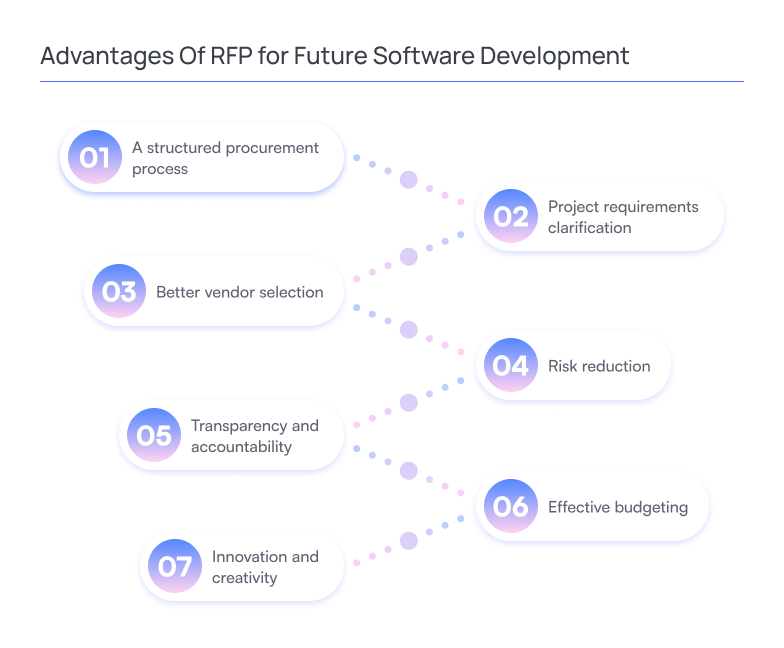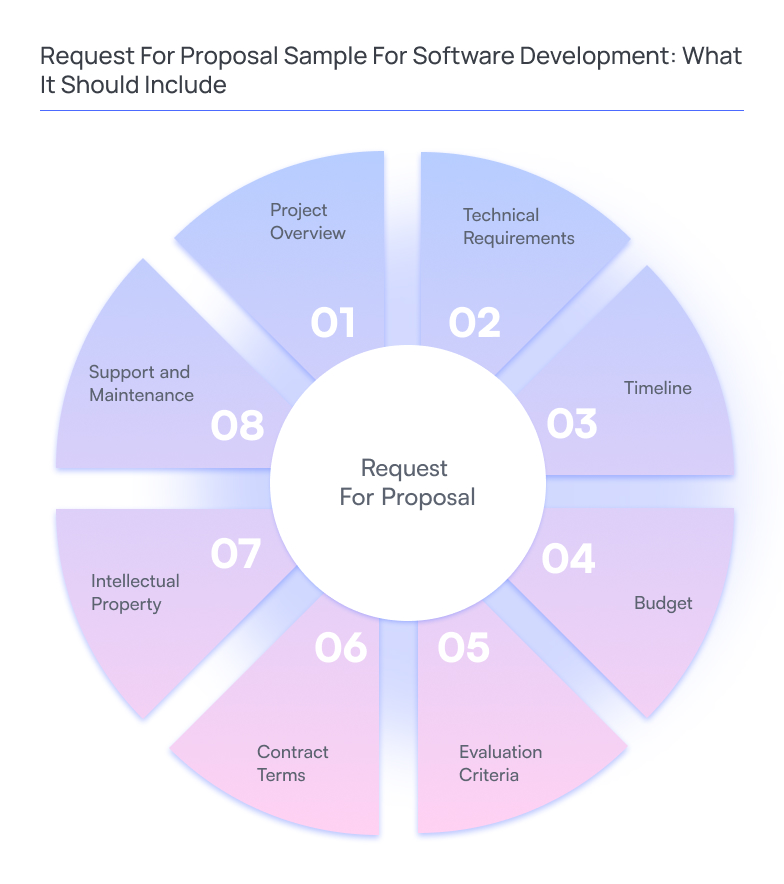Nowadays, software development has become a critical factor for many businesses. Whether you need a new application to streamline internal processes or customer-facing software to enhance user experience, choosing the right software development company is essential. But with so many options available, how do you ensure you find the right fit for your project?
One effective way to select the right software development company is by creating a Request for Proposal (RFP).
This article will discuss how to write an RFP for software development. We will explain what benefits RFP has and what points it should include. Whether you’re a small business owner or a large enterprise, this guide will help you create an RFP that will help you find the right software development company for your project.
What Is A Request For Proposal For Software Development? (RFP)
A request for proposal for software development is a document that outlines the requirements and specifications for a software development project and invites potential vendors to submit proposals.
The RFP details the project’s objectives, scope, timeline, budget, and any specific technical or functional requirements.
What Is The Purpose of an RFP?
Simply put, a request for proposal (RFP) is a detailed list of questions submitted to software vendors. The purpose of an RFP is to solicit proposals from software development companies capable of delivering the desired software product or solution.
By issuing an RFP, businesses can evaluate vendors based on their proposed approach, experience, expertise, and cost. As a result, the RFP process enables companies to make informed decisions about selecting the right vendor for their project and ensure that their software development needs are met.

An effective RFP for software development should provide a comprehensive overview of the project’s objectives, requirements, and constraints. In addition, the document should be structured to allow vendors to understand the project’s scope and client expectations. The RFP should also include instructions on submitting proposals, evaluation criteria, and timelines for the proposal process.
Who Creates RFPs?
Typically, a software development RFP should be written by a company or organization needing software development. It can be any business, nonprofit, government agency, or other entity with a specific software development project in mind.
Someone who understands the project requirements, scope, goals, budget, and timeline can write a software development RFP. For example, a project manager, product owner, other relevant stakeholders, or even a Proposal Writer – some companies already create a position where professional writers make RFPs.
If the organization has a procurement or purchasing department, they may also be involved in drafting the RFP and managing the procurement process. Therefore, involving relevant stakeholders and subject matter experts is critical to ensure that the RFP accurately reflects the organization’s needs and requirements.
Advantages Of RFP for Future Software Development
Writing an RFP for software development may benefit your business. RFP provides the following advantages for your future product.

- A structured procurement process. One of the primary benefits of using an RFP for software development is that it provides a structured approach to procurement. Thus, it helps ensure that all vendors or contractors have an equal opportunity to bid on the project and the selection process is fair and objective.
- Project requirements clarification. Due to RFP, the company can clearly define the project requirements, expectations, and objectives. As a result, all the project’s and organization’s goals will be met, and the final product will meet the desired outcomes.
- Better vendor selection. The RFP process enables the organization to solicit proposals from multiple vendors or contractors. It facilitates the vendor selection process, as the organization can compare the proposals and choose the vendor that best meets its needs and budget.
- Risk reduction. By defining the project requirements and expectations in the RFP, the organization can reduce the risk of misunderstandings and miscommunication during the project. So the project will be completed on time and within budget and adhere to the desired quality standards.
- Transparency and accountability. The RFP process promotes transparency and accountability, as all vendors or contractors are given the same information and are evaluated based on the same criteria. As a result, the selection process is fair, and the chosen vendor is held accountable for meeting the project requirements.
- Effective budgeting. The budget for the project can be defined upfront by the client. So the vendor proposals will meet the budgetary constraints, and there won’t be unexpected situations.
- Innovation and creativity. The RFP process can encourage innovation and creativity, as vendors or contractors may propose alternative solutions or approaches that the organization still needs to consider. It may lead to more innovative and effective solutions, resulting in a better product.
No time to read the article carefully?
Contact Bineralsto have detailed consultation on your issue.
Request For Proposal Sample For Software Development: What It Should Include
When you start writing an RFP for mobile or web app development, you should know what necessary points the IT RFP template may include. Let’s check the primary points.

Project Overview
The RFP should include a detailed overview of the project, including its goals, objectives, and scope. This will help potential vendors understand the project and determine whether they are a good fit.
Provide a brief introduction to the project and its purpose. Explain why the software is needed, what it is intended to accomplish, and how it will benefit the organization. Also, define the project’s scope, including the software’s functionalities and the platforms it should support.
We can show a short example of an IT RFP document for dating app development:
Background:
Our company is seeking a software development team to create a dating app that caters to the needs of our target audience. The app should be user-friendly, visually appealing, and provide a safe and secure environment for users to connect.
Scope:
The dating app should include the following functionalities:
- User registration and profile creation
- Matching algorithm based on user preferences
- Messaging system to enable communication between users
- Search filters to allow users to find potential matches based on specific criteria
- In-app purchases for premium features
- Integration with social media platforms for easy sign-up and user verification
Of course, the project overview and the whole RFP will be much longer, this is a sample for you how it may look like. By the way, we have a detailed guide on how to create a dating app, so check it out.
Technical Requirements
The RFP should outline the technical requirements for the project, including programming languages, frameworks, and platforms. Vendors will explore this information to determine whether they have the necessary skills and expertise to complete the project.
You need to specify the system architecture and infrastructure required to build the software. Include details about hardware and software requirements, network requirements, and hosting environments. Provide information on the user interface, including design requirements, user flow, navigation, and responsiveness. Specify any requirements related to graphics, icons, and other visual elements.
Besides, technical requirements should include data about the database, security requirements, mobile platforms (if any), etc.
Let’s check a brief example of an RFP for social media app development:
System Architecture:
- The social media app should be developed using a cloud-based architecture and hosted on a scalable and secure cloud platform.
- The platform should be able to handle high traffic and scale horizontally.
User Interface:
- The app should have an intuitive, modern, and responsive user interface, with consistent design elements across all platforms (iOS, Android, web).
- The app should be accessible to users with disabilities and support right-to-left languages.
Database:
- The app should use a relational database system (for example, MySQL, PostgreSQL) to store user data, posts, and other app-related information.
- The database should be scalable and have a redundant backup system.
Read also our article on how to build a social media app. It will be valuable for you.
Timeline
Your RFP should include the timeline for the project. Here are some key elements to consider when creating a timeline for your software development RFP:
- Project Start Date: Specify the project’s expected start date and duration.
- Milestones: Break down the project into key milestones, such as completion of design, development, testing, deployment, and training.
- Deadline for Each Milestone: Set specific deadlines for each milestone and briefly explain what should be achieved by each deadline.
- Dependencies: Identify any dependencies between milestones or tasks, and include them in the timeline to ensure the project stays on track.
- Review Periods: Allow time for review and feedback at each project stage, and include a deadline for submitting feedback and approvals.
Budget
Mind to add a project budget in the RFP template for IT services. It should include a detailed breakdown of the budget, including the software development costs, any additional services, and the timeline for completion. The budget point will help the software development company understand the project’s scope and the resources they need to allocate.
Additionally, comprehensive budget information will help the company determine if it can meet the budget and timeline requirements. A detailed budget section in the RFP will help ensure the software development project is completed on time and within budget.
You must include payment terms and conditions, such as payment schedules and invoicing requirements. Specify the payment method, such as wire transfer, check, or credit card.
Evaluation Criteria
The request for proposal must specify the evaluation criteria you will use to evaluate proposals objectively. Here are some evaluation criteria examples:
- Technical expertise. This criterion assesses the vendor’s technical knowledge and experience. You can determine this by asking for references and reviewing the vendor’s portfolio of past work.
- Experience. It will help you evaluate the vendor’s experience in developing software solutions similar to your request. Ask for references and review the vendor’s portfolio to assess their experience.
- Cost. The vendor’s proposed cost for the project. You should evaluate this based on the cost of the services provided and any additional costs, such as travel or equipment expenses.
- Quality assurance. The vendor’s quality assurance approach, including their processes for testing and debugging. You can evaluate this by requesting a detailed quality assurance plan and reviewing the vendor’s methodology.
Contract Terms
The request for a proposal template for software development includes clear and specific contract terms that will govern the relationship between your organization and the vendor. They can be the following:
- Payment terms. Outline the payment terms, including the payment amount and timing, and any penalties for late payment or non-payment.
- Confidentiality and non-disclosure. Include provisions for confidentiality and non-disclosure of sensitive information related to the project, including any trade secrets or proprietary information.
- Warranties and guarantees. Specify any warranties or guarantees the vendor must provide related to the quality of their work, performance, and software functionality.
- Termination clauses. Include provisions for contract termination, including the circumstances under which either party may terminate the contract and any associated penalties or obligations.
- Dispute resolution. Specify the process for resolving any disputes arising during the project, including mediation or arbitration.
Intellectual Property
Intellectual property (IP) is a crucial consideration in any software development project, and it is essential to include specific provisions related to IP in your Request for Proposal (RFP). Here are some guidelines to consider when addressing IP in your RFP:
- Define the ownership of IP. Clearly define who will own the IP rights to any software developed in the project. The source code, design elements, and associated patents, trademarks, or copyrights can be included.
- Specify any licenses required. If the vendor uses any third-party software or components as part of the project, specify any licenses required to use that software and ensure that the vendor has obtained the necessary licenses.
- Address ownership of pre-existing IP. If either party brings pre-existing IP to the project, specify who will own the rights to that IP and how it will be used in the project.
- Clarify the use of open-source software. If the vendor will be using any open-source software as part of the project, specify any required licenses, and ensure that the vendor has complied with the terms of those licenses.
Support and Maintenance
The last but not least point is support and maintenance. Your RFP should contain specific provisions about it. Check them below:
- The scope of support and maintenance. Clearly define the range of support and maintenance services the vendor will provide, including the expected response times, hours of operation, and the issues that will be covered.
- The duration of support and maintenance. Specify the duration of the support and maintenance services, including any extensions or renewals that may be available.
- The cost of support and maintenance. Clarify the cost of the support and maintenance services, including any ongoing fees or associated costs.
- The process for reporting and resolving issues. Specify the process for reporting and resolving issues related to the software, including the expected response times, escalation procedures, and the process for submitting bug reports.
- The process for updates and upgrades. Specify the process for updates and upgrades to the software, including the expected frequency of updates, the process for testing and deployment, and any associated costs.
How To Create An RFP For Software Development And Avoid Main Mistakes
Finally, you must remember that creating an RFP for software development is complex. You should know how to avoid common mistakes resulting in wasted time and resources. Here are some tips to help you avoid common mistakes when creating an RFP for software development:
- Failing to define precise requirements. One of the biggest mistakes when creating an RFP is failing to define requirements clearly. You must provide a detailed scope of work and explain the technical and functional requirements and any constraints, such as timeline or budget. So vendors will be able to understand your expectations and submit a proposal that accurately reflects your needs.
- Using unclear formulations. Being too vague in your RFP can lead to confusion and misunderstandings. Avoid using ambiguous language or generic terms; provide specific details wherever possible. With greater detail, the vendors will understand your requirements and submit a more accurate proposal.
- Lack of Information. Providing insufficient information in your RFP can result in vendors offering recommendations that are not well-suited to your needs. Ensure to include all relevant information, such as the project timeline, budget, technical requirements, and any other information vendors may need to submit an accurate proposal.
- Failing to specify evaluation criteria. Failing to specify evaluation criteria can make it challenging to evaluate proposals objectively. Define the criteria that you will use to assess proposals, such as experience, technical expertise, or cost.
- Overcomplicating. Overcomplicating the RFP can lead to confusion and make it difficult for vendors to understand your requirements. Keep the RFP simple and concise, and avoid using technical jargon or industry-specific terminology that may not be familiar to all vendors.
Summing Up
It is impossible to evaluate how much time it will take to create an RFP for your mobile or web development. The request for proposal should include a lot of necessary information, so you need to consider every tiny detail when making an RFP. Apart from the mentioned points, you can add other essential information for your future project.
Anyway, Binerals is at your service, and we are always open to new projects, so contact us, and we will help you create the request for proposal considering all your business nuances and requirements.
to make your software – we know how to make it right!
FAQ
What is a Request for Proposal (RFP) for software development?
A Request for Proposal (RFP) for software development is a document that outlines the requirements, goals, and expectations for a software development project and requests proposals from potential vendors to complete the project.What benefits does an RFP have for software development projects?
The request for a proposal ensures a structured procurement process. It allows you to clarify all the project requirements, hire the best vendor, reduce possible risks, obtain transparent services, and have effective budgeting. Also, an RFP can help encourage creativity and improve your future project.What should be included in an RFP for software development?
An RFP for software development should include a detailed description of the project requirements and goals, an estimated timeline and budget for the project, criteria for selecting a vendor, and provisions related to intellectual property, support, and maintenance.